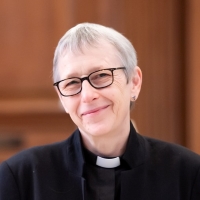As some of you will be aware, every season in the Church’s calendar is colour-coded. That is why the altar frontal behind me changes from time to time. If we are in what is called ‘ordinary time’, it is green. If it is a time of celebration, such as Christmas or Easter, we have white; in the penitential seasons of Advent and Lent we have dark blue or purple. Red is the colour of the Holy Spirit, and of the Kingship of Christ. And this colour-coding extends to special individual days as well, including today, when we celebrate St James the Apostle. The reason why the altar frontal behind me is red, is because James was not only a saint, but also a martyr, and red is the colour of martyrdom.
However, there is one very interesting and unusual feature of our own red altar frontal here, which has always struck me as odd, but which, as it happens, makes it particularly appropriate for us to use on this specific occasion. Because if you look carefully, you can perhaps see along the top of the frontal the first of three images of scallop shells. And the scallop shell happens to be the image most closely associated with St James – and for that reason, it has also become the traditional symbol of the Christian pilgrim.
St James the Great was one of the twelve disciples. He is mentioned in the Gospels as one of the sons of Zebedee, a fisherman who, along with his brother John, was called to follow Jesus. We are told of his presence at the raising of Jairus’s daughter from the dead, at the Transfiguration on Mount Tabor, and also in the Garden of Gethsemane on the night that Jesus was arrested. We also learn of the eventual fate of James, in Acts chapter 12 – where, we are told, he was beheaded by Herod Agrippa – he was one of the very first Christian martyrs.
It was believed that before his return to Jerusalem, where he met his death, James had travelled to Iberia, to the region that is now Galicia, in north-west Spain, to preach the Gospel there. The story goes that his body was subsequently returned there, to be re-discovered in the 8th century. A shrine was created there, around which arose what is today the city Santiago de Compostela, which became a major site for Christian pilgrims from across Europe. And so it was that the Camino, ‘the way of St James’, became a famous pilgrimage route more than a thousand years ago.
The explanations that are given as to why the scallop shell was to become the abiding symbol of pilgrims, particularly associated with this route and with St James, are various. The scallop is native to Galicia, and those who completed the route to Santiago were give a badge in the form of a shell. Pilgrims began wearing these shells as signs to identify themselves as such to any whom they met on the road. This gave them certain privileges: they could sleep in churches, and could ask for free meals; but it could also give them a measure of protection on their journey, from thieves and robbers, who were wary of assaulting someone engaged in such a holy pursuit, who was under the protection of God. The shell could have practical uses, too – it could be used as a scoop from which to drink water, or food.
These days the scallop shell has become the standard symbol of direction along the Camino route itself. It can be seen on walls, signposts and churches, pointing pilgrims towards Santiago. The sign of the shell also generates camaraderie amongst fellow pilgrims who bear that badge, providing instant mutual recognition. Some have interpreted the grooves in the scallop shell as symbolising the many paths that lead to one point, as pilgrims travel from far and wide to gather together at the shrine that is their shared destination.
Last year our planned St Bride’s pilgrimage, sadly thwarted by Covid, included part of the Camino pilgrim route that goes through Germany towards Spain, the Jakobsweg, so my own plans to walk part of the route have yet to be fulfilled – although there are certainly members of St Bride’s, and other members of my own family, who have walked parts of the Camino.
However, I have undertaken other pilgrimages on foot, over the years. The first time I did so was in my twenties, when I was training for ministry, when a group of my fellow students and I walked from Oxford to Winchester during Holy Week, arriving at the Cathedral in time for the Chrism Mass on Maundy Thursday. And so I can speak from personal experience of how powerful and significant such undertakings can be.
Pilgrimages were big business in mediaeval Europe, but at the Reformation much of that tradition was swept away. In England, Pilgrimages were banned, along with relics, shrines, and the veneration of the saints, and it would be 300 years before they made a reappearance.
Which makes the recent resurgence of interest in the following of ancient pilgrim trails, and the rediscovery of some routes that had been lost for centuries, all the more fascinating. Indeed, in one of his sermons last Sunday, Jeff made reference to a rediscovered pilgrim route that he recently followed with Sandra.
Just to give you some insight into how significant this is: in 1984, a mere 423 pilgrims completed the final 100 km stretch of the Camino pilgrimage route, which earned them their official pilgrims’ certificate. By 2006 this number had increased to over 100,000, and ten years later, in 2016, it was approaching 300,000. Covid restrictions apart, the pilgrimage industry is booming. Which begs the question, what is going on here?
There was an article in the Guardian back in 2017 describing this extraordinary phenomenon, which noted that it is not only devout Christians who are undertaking these challenging journeys, but also people of no faith. All were discovering the joys of what the article described as ‘slow travel on foot with strangers’.
So what is it that people are seeking, and finding, when they commit themselves to undertaking one of these ancient journeys? It would seem that it is putting us back in touch with something of profound human significance, which the noise and busyness of modern life can so easily obliterate. Instead of racing around frantically, travel by foot takes place at a natural human speed; at a pace that enables you to notice the world around you; to be able to pause when you see something of beauty or hear something of interest in nature, or when you encounter a glimpse of something human and ancient. A pace at which your mind and your body can travel together and at the same speed, rather than one racing to keep up with the other. And, at the level of simple ‘bodilyness’, to be able to feel the warmth of the sun, but also the bracing power of the rain, in a sustained and purposeful way. To discover the limits of one’s own physical endurance, and inner resolve. To be able to spend time away from the harsh, loud sounds that are the constant backdrop to contemporary life. And many modern-day pilgrims speak of the relationships formed on their travels: existing associations deepened; new friendships discovered.
As many will testify, contrary to what one might assume, the true importance and significance of pilgrimage is to be found, not in reaching one’s intended destination, but within the very process of travelling. The discovery of those moments of grace, and moments of profound peace, often when one least expects them.
The busyness of life can so easily disconnect us from what makes us human; and when we re-connect we often find ourselves encountering something that goes beyond our expectations and beyond the purely human – as we find ourselves engaging with transcendence, if only for the occasional fleeting moment.
The late poet and former priest, John O’Donohue, wrote a poem of blessing entitled ‘For the Traveller’, which encapsulates this kind of experience beautifully, but also reminds us that we do not have to go on a special pilgrimage to experience its riches. This was something I myself discovered during lockdown, where for the first time in many, many years, I got into the habit of going everywhere on foot, here in central London. Here are some extracts from that poem of blessing:
Every time you leave home
Another road takes you
Into a world you were never in […
When you travel, you find yourself
Alone in a different way,
More attentive now
To the self you bring along.
Your more subtle eye watching
You abroad, and how what meets you
Touches that part of the heart
That lies low at home …
When you travel,
A new silence
Goes with you,
And if you listen,
You will hear
What your heart would
Love to say.
A journey can become a sacred thing.
Make sure, before you go,
To take the time
To bless your going forth,
To free your heart of ballast
So that the compass of your soul
Might direct you towards
The territories of spirit
Where you will discover
More of your hidden life;
And the urgencies
That deserve to claim you.
May you travel in an awakened way,
Gathered wisely into your inner ground;
That you may not waste the invitations
Which wait along the way to transform you.
May you travel safely, arrive refreshed
And live your time away to its fullest;
Return home, more enriched, and free
To balance the gift of days which call you.
Amen.



